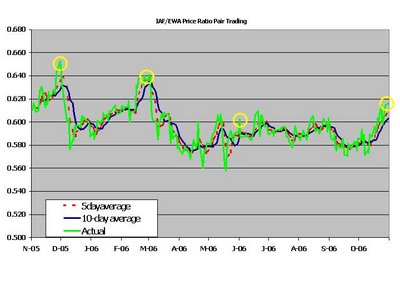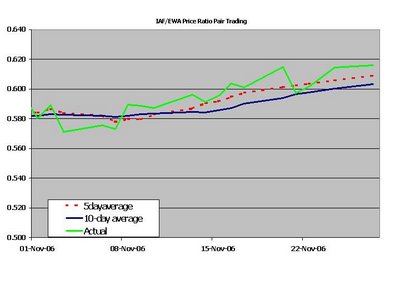Along with my passion around finding those great long-term stock prospects, I enjoy executing various hedge and arbitrage strategies. In this post, I would like to highlight a pair trade opportunity that is too good to pass up.
Before I get started, I would like to level-set for everyone. Pair trades are one of the strategies commonly used by hedge funds. The idea is to buy a stock that is expected to perform well and short another stock in the same industry which is expected to underperform. When selecting this strategy, I prefer to use ETF's and/or stock funds to get this as close to market neutral as possible. I typically perform this strategy to try and capture dividend risk free in a short time frame. As I was scanning to find a stock that is on ex-dividend in the next week or so, I came across IAF.
Aberdeen Australia Equity Fund, Inc. (IAF) operates as a closed-end, nondiversified management investment company. It invests primarily in equity securities, consisting of common stock, preferred stock, and convertible stock of Australian companies. The fund’s investment portfolio comprises various sectors, such as consumer discretionary, consumer staples, energy, financials, industrials, materials, property, telecommunication services, and utilities. Aberdeen Asset Management Limited serves as the investment advisor of the fund. Aberdeen Australia Equity Fund was founded in 1985 and is based in Plainsboro, New Jersey.
Dividend Yield of 9.0% - Very Attractive
Ex-Dividend Date on 11.30.2006
Dividend per share of 0.32 per share paid quarterly
From there, I look for IAF's perfect match, a stock/fund or ETF that is highly correlated with the Australian stock market...As I go to Yahoo Finance and scan the available ETFs, there in the distant awaits EWA. You have to love the new world of exchange traded funds.
iShares MSCI Australia Index (EWA) seeks to provide investment results that correspond generally to the price and yield performance of publicly traded securities in the Australian market, as measured by the MSCI Australia index. The fund uses a representative sampling strategy to try to track the index. The index consists of stocks traded primarily on the Australian Stock Exchange.
The next step is to plot the ratio of the two symbols. I've captured the historical daily close prices adjusted for dividends, for the last year of trading from the Yahoo Finance historical quotes section. Here are some of the key statistics of the pair:
Correlation of IAF / EWA is 89.6%
I prefer to keep this range in the 80-90% range. To mitigate risk, you should elect this number to be closer to 100%, which also impacts the amount of profit that can be captured.
Price Ratio Averages of IAF divided by EWA (adjusted for the upcoming dividend on 11.30.06)
1 year 0.597
10 day 0.605
5 day 0.608
Min 0.558
Median 0.594
Max 0.653
The rationale:
Over the last year, IAF has paid a hefty dividend yield that attracts many shareholders to buy and/or hold through the ex-dividend date. Right after the ex-dividend date, there is a higher amount of selling of IAF relative to its peer EWA. The chart below highlights the price ratio of IAF/EWA through the last 4 dividend dates from IAF.
Here is the daily price ratio for the last year with the ex-dividend dates highlighted in yellow circle.

Zooming in closer, here is the same data for the last month.

As of 11.28.2006, the price ratio is .611. Since the latest price ratio falls between the 3rd and 4th quartiles of the annual range, I will elect to short the ratio. Shorting the ratio entails the following trade:
Portfolio Size: $25,000
Opening Trades:
Purchase 535 shares of EWA at $23.38 per share worth $12,500
Short 856 shares of IAF at $14.60 per share worth $(12,498). I am entering IAF at a pre-dividend price because I will be paying out the dividend of 0.32 per share since I am short the stock.
When I enter these trades, I plan on unwinding the pair trade once the price ratio falls withing the 2nd and 3rd quartile. In this instance, my goal is for a price ratio of .607 or lower. Assuming I exit the trade in 5 days at .607, I get an annual APR of 38.5% on a 250 day basis. When I count in a $9.99 per trade commission fee, I get to a 22.5% return before taxes applied to my short-term capital gains.
Stay tuned for the results of this pair trade........
Disclosure: This strategy is highlighted for entertainment purposes. I am neither long IAF nor short EWA.

















